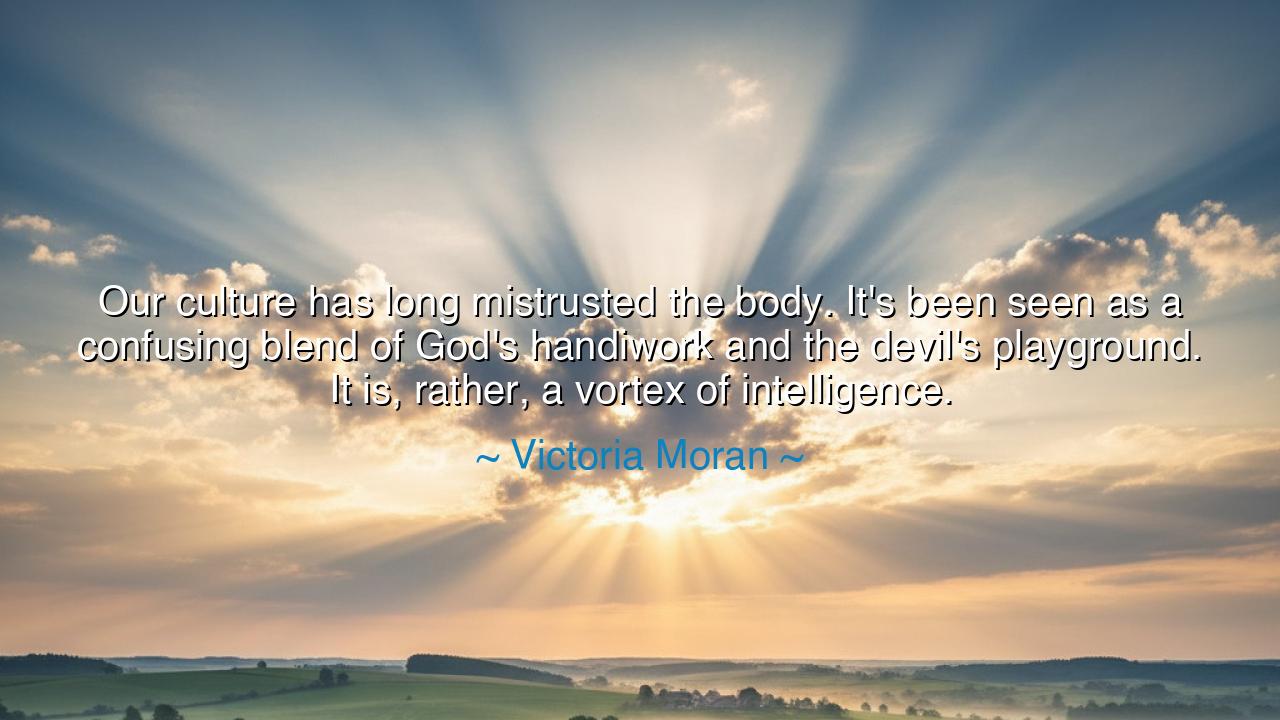
Our culture has long mistrusted the body. It's been seen as a
Our culture has long mistrusted the body. It's been seen as a confusing blend of God's handiwork and the devil's playground. It is, rather, a vortex of intelligence.






When Victoria Moran wrote, “Our culture has long mistrusted the body. It’s been seen as a confusing blend of God’s handiwork and the devil’s playground. It is, rather, a vortex of intelligence,” she was speaking not merely of flesh and bone, but of the sacred vessel through which life itself reveals its mystery. Her words carry both lament and revelation — a lament for the centuries in which humanity has feared its own physical being, and a revelation that the body is not the enemy of the spirit, but its companion, its teacher, and its voice. In this statement, Moran challenges one of the oldest fractures in human thought — the false divide between body and soul.
For countless generations, societies, both Eastern and Western, have treated the body with suspicion. In the traditions of the West, this mistrust was rooted in the belief that the physical world was fallen — that the body was a site of temptation, a whispering serpent luring the spirit away from divine purity. The ancient Greeks exalted reason and intellect above the mortal frame; the medieval Church often treated flesh as a burden to be subdued. Even in modern times, echoes of this dualism persist: the mind is praised, the spirit is worshiped, but the body is disciplined, starved, sculpted, and shamed. Moran’s words cut through this ancient fog, declaring that the body is not a battlefield between heaven and hell, but a vortex of intelligence — a living, breathing network of wisdom, intuition, and truth.
To call the body a “vortex of intelligence” is to restore it to its rightful place in the cosmos. It is to recognize that wisdom is not confined to the brain or the soul, but pulses through every heartbeat, every breath, every cell. Modern science, in its own way, confirms what the mystics long intuited: the body remembers, it communicates, it knows. The stomach carries its own neural system; the heart sends signals that shape emotion and thought; the immune system responds with an awareness that borders on foresight. What Moran calls a “vortex” is this swirling unity of instinct, sensation, and spirit — the sacred conversation between the physical and the divine.
Consider the story of Martha Graham, the legendary dancer who revolutionized modern movement. She once said, “The body says what words cannot.” In her art, she did not tame the body — she freed it. Her performances were not polite or graceful in the classical sense; they were fierce, trembling, primal. Through motion, she expressed grief, desire, ecstasy — the full range of the human condition. Critics at first found her work disturbing, too raw, too unrestrained. Yet what she revealed through dance was exactly what Moran describes: that the body is not merely a servant of thought, but an intelligence of its own, one that speaks a deeper truth than language can carry.
Moran’s insight also serves as an act of healing for a culture sickened by disconnection. We live in an age where many are estranged from their own bodies — trapped in screens, driven by anxiety, numb to the quiet wisdom of breath and hunger and rest. We treat the body as an obstacle to transcend, a project to perfect, or a machine to exploit. But in doing so, we lose the very key to balance and joy. The ancients who truly understood life — the yogis of India, the healers of the Americas, the philosophers of China — all knew that the path to enlightenment begins not by fleeing the body, but by listening to it. The body is the temple, and its sensations are the hymns through which the soul speaks.
Thus, Moran’s words call us to a great reconciliation: to bring spirit and body back into harmony. She asks us to honor the body not as a vessel of sin, nor merely as a machine of survival, but as an instrument of divine intelligence — a guide that teaches us how to live truthfully. To feel hunger is to know humility. To feel pain is to learn empathy. To breathe deeply is to remember that we belong to the living world. The body, when treated with reverence, becomes a teacher far wiser than any doctrine, for it speaks the language of experience, presence, and life itself.
And so, take this teaching into your heart: mistrust not your body, for it is your oldest ally. When you feel sorrow in your chest, when joy fills your limbs, when instinct warns you of danger — listen. The body is the compass of the soul, the keeper of its most intimate truths. Treat it with kindness; nourish it with rest, with movement, with gratitude. For as Moran teaches, to reclaim the body as a vortex of intelligence is to reclaim the wholeness of being — to stand not as spirit against flesh, but as human: radiant, unified, and profoundly alive.






AAdministratorAdministrator
Welcome, honored guests. Please leave a comment, we will respond soon